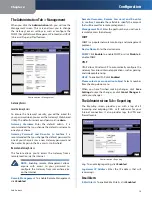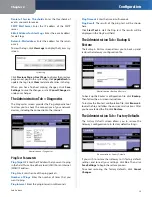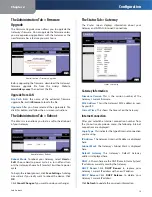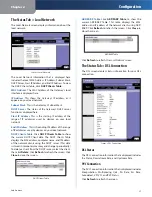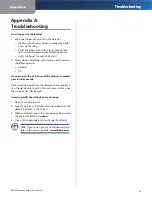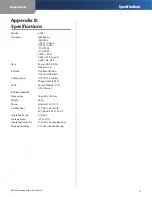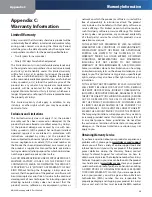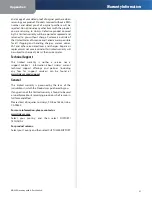
Chapter 2
Configuration
6
SubProduct
The Setup Tab > DDNS
The Gateway offers a Dynamic Domain Name System
(DDNS) feature. DDNS lets you assign a fixed host and
domain name to a dynamic Internet IP address. It is useful
when you are hosting your own website, FTP server, or
other server behind the Gateway.
Before you can use this feature, you need to sign up for
DDNS service at DynDNS.org or TZO.com.
DDNS
DDNS Service
If your DDNS service is provided by
DynDNS.org, then select
DynDNS.org
from the drop-
down menu. If your DDNS service is provided by TZO, then
select
TZO.com
. The features available on the DDNS screen
will vary, depending on which DDNS service provider you
use. To disable DDNS Service, select
Disabled
.
DynDNS.org
Setup > DDNS > DynDNS.org
User Name, Password, Host Name
Enter the user name,
password, and host name of your DynDNS.org account.
Internet IP Address
The Gateway’s current Internet IP
address is displayed here. Because it is dynamic, it will
change.
Status
The status of the DDNS service connection is
displayed here.
TZO.com
Setup > DDNS > TZO.com
E-mail Address, Password, Domain Name
Enter the
e-mail address, TZO password key, and domain name of
the service you set up with TZO.com.
Internet IP Address
The Gateway’s current Internet IP
address is displayed here. Because it is dynamic, it will
change.
Status
The status of the DDNS service connection is
displayed here.
When you have finished making changes to this screen,
click
Save Settings
to save the changes, or click
Cancel
Changes
to undo your changes.
The Setup Tab > Advanced Routing
The
Advanced Routing
screen allows you to configure the
dynamic and static routing settings.
Setup > Advanced Routing
Advanced Routing
Operating Mode
NAT
NAT is a security feature that is
Enabled
by default. It
enables the Gateway to translate IP addresses of your local
area network to a different IP address for the Internet. To
disable NAT, click the
Disabled
radio button.
Dynamic Routing
With Dynamic Routing you can enable the Gateway to
automatically adjust to physical changes in the network’s
layout. The Gateway, using the RIP protocol, determines
the network packets’ route based on the fewest number
of hops between the source and the destination. The RIP
protocol regularly broadcasts routing information to other
Gateways on the network.
RIP
To enable RIP, click
Enabled
. To disable RIP, click
Disabled
.

















